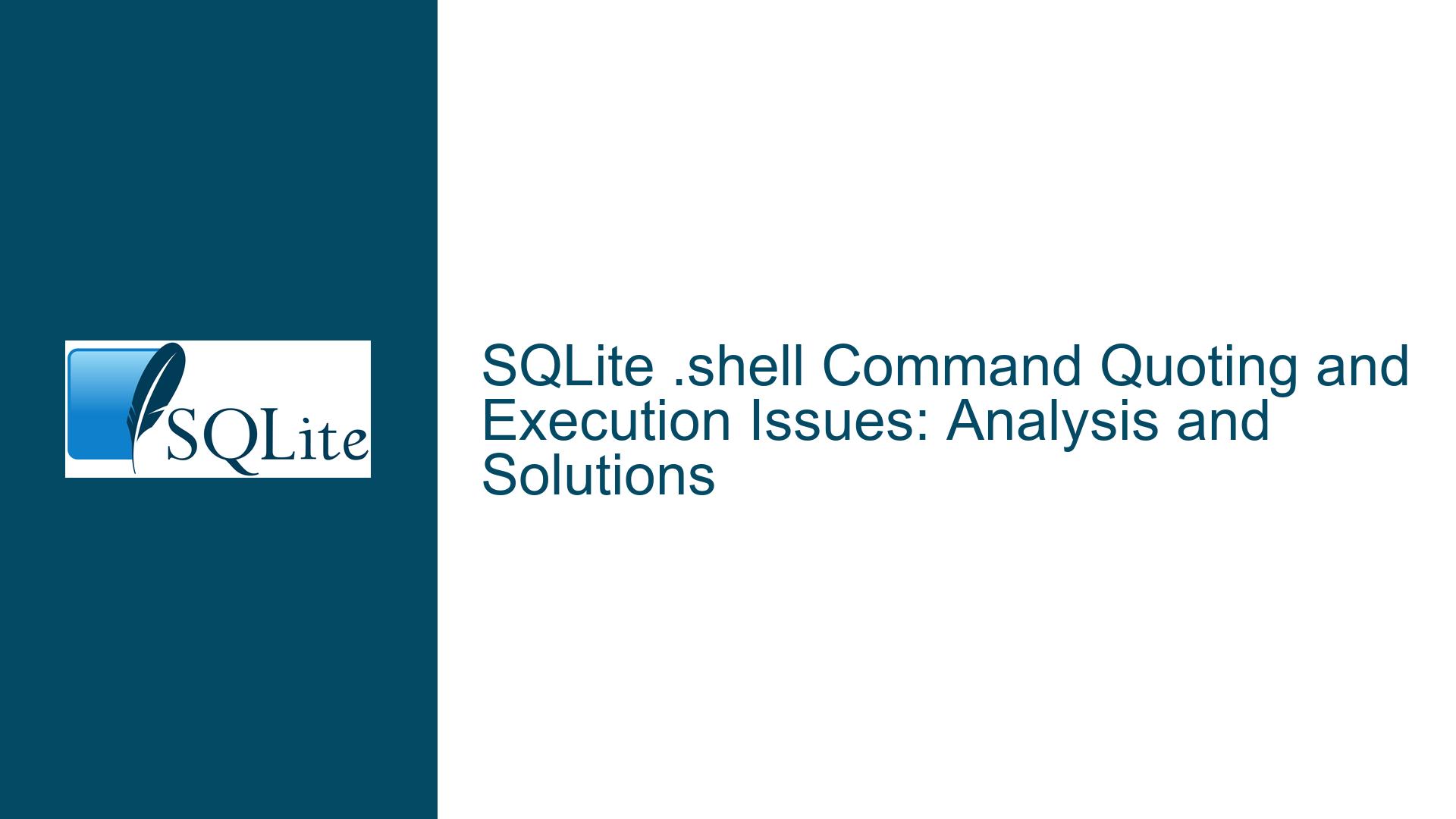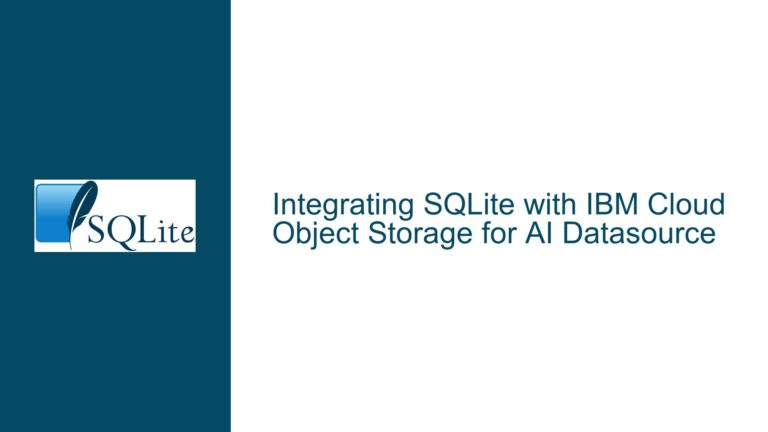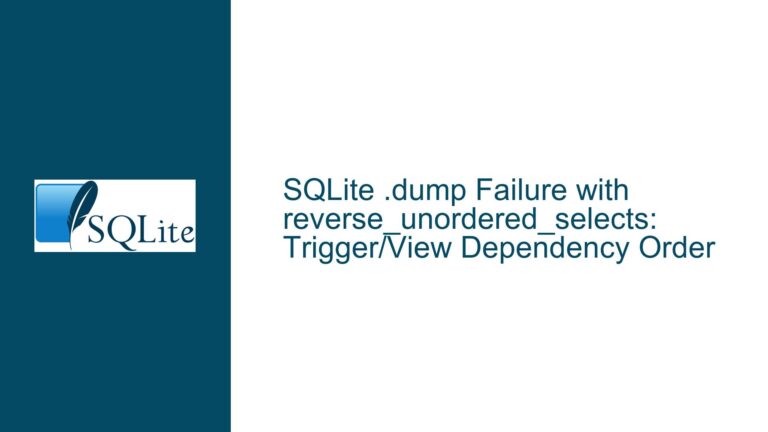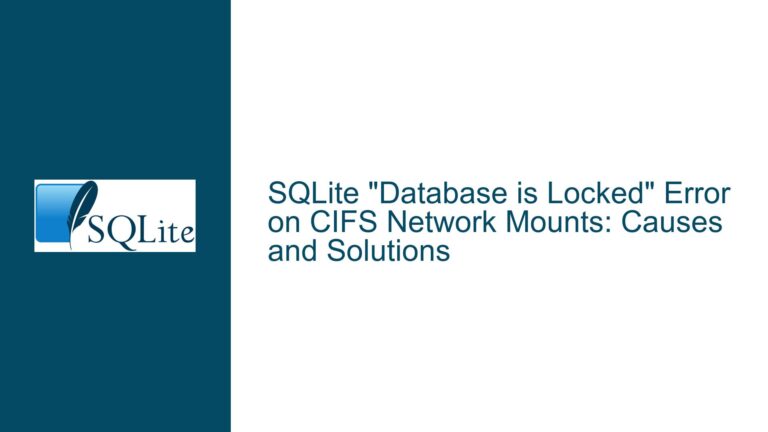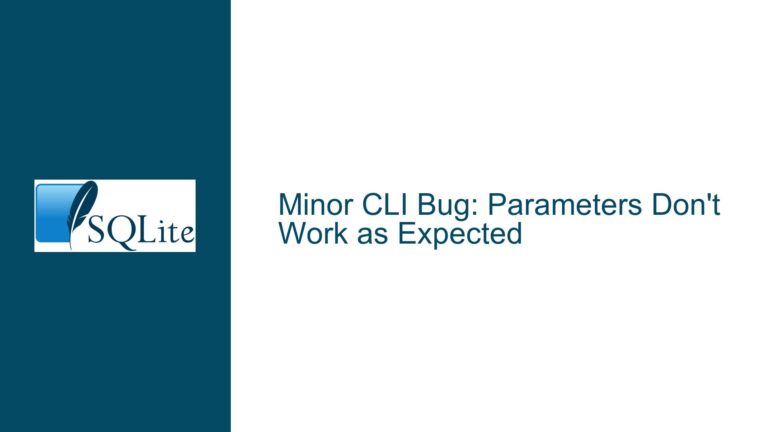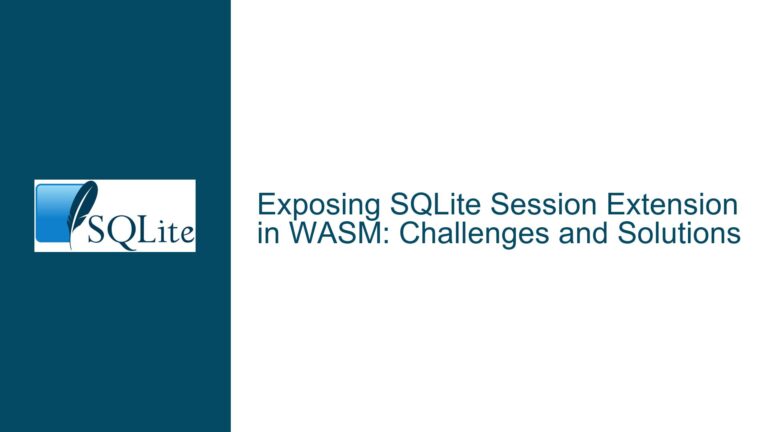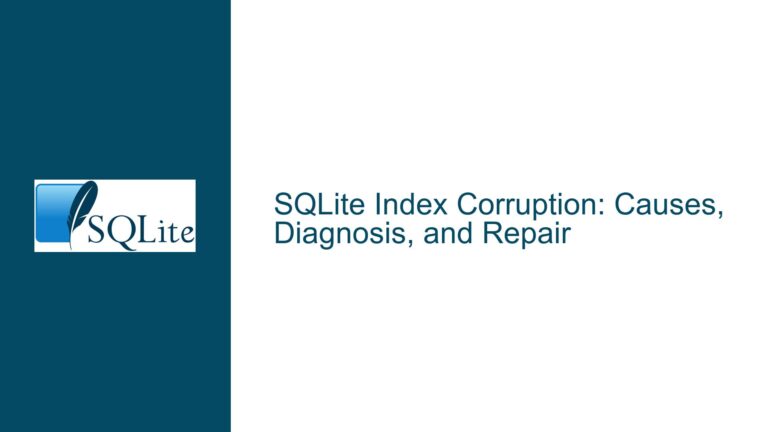SQLite .shell Command Quoting and Execution Issues: Analysis and Solutions
Issue Overview: .shell Command Quoting and Execution Problems
The .shell command in SQLite is designed to allow users to execute shell commands directly from within the SQLite shell. However, the current implementation of this command has several notable deficiencies, particularly in how it handles command quoting and argument parsing. These issues can lead to unexpected behavior, especially when dealing with spaces, empty arguments, or complex shell syntax such as pipelines and redirections.
The core of the problem lies in the way the .shell command constructs the shell command string. The current implementation uses sqlite3_mprintf to concatenate arguments, applying quoting rules that are not universally compatible with all shell environments. This approach can result in arguments being misinterpreted or dropped entirely, particularly on systems where the shell syntax differs from the assumptions made by the SQLite implementation.
Furthermore, the .shell command does not handle multilayered quoting well, which is a common requirement when dealing with nested commands or complex shell syntax. This limitation can make it difficult for users to execute commands that require precise control over quoting and argument passing.
Possible Causes: Inefficient Quoting and Shell Compatibility
The primary cause of the .shell command’s issues is its reliance on a simplistic and outdated approach to command construction. The current implementation was likely written before the availability of more robust string handling utilities like sqlite3_str, and it has not been updated to take advantage of these improvements. As a result, the command suffers from several limitations:
Inefficient Quoting Mechanism: The
.shellcommand uses a basic quoting mechanism that does not account for the complexities of different shell environments. For example, it applies double quotes around arguments containing spaces, but this approach does not work well with all shells, particularly on Windows where thesystemfunction may invoke a different command interpreter.Loss of Empty Arguments: The current implementation fails to handle empty arguments correctly. When an empty argument is passed to the
.shellcommand, it is simply dropped, which can lead to incorrect command execution. This behavior is particularly problematic when dealing with commands that require precise argument positioning.Limited Support for Complex Shell Syntax: The
.shellcommand does not provide full support for complex shell syntax such as pipelines, redirections, and command substitutions. While these features are not essential for all use cases, they are often required by advanced users who need to perform more sophisticated operations from within the SQLite shell.Cross-Platform Inconsistencies: The behavior of the
.shellcommand can vary significantly between different platforms. For example, on Windows, the command may work differently than on Unix-like systems due to differences in how thesystemfunction is implemented and how shells handle quoting and argument parsing.
Troubleshooting Steps, Solutions & Fixes: Enhancing .shell Command Robustness
To address the issues with the .shell command, several steps can be taken to improve its robustness and compatibility across different platforms and shell environments. These solutions range from minor adjustments to the existing implementation to more significant changes that involve deprecating the current command and introducing a new, more reliable alternative.
Improve Quoting and Argument Handling: The first step in resolving the
.shellcommand’s issues is to improve its quoting and argument handling mechanisms. Instead of usingsqlite3_mprintfto construct the command string, the implementation should be updated to usesqlite3_stror a similar utility that provides more robust string handling capabilities. This would allow for better handling of spaces, empty arguments, and special characters.Additionally, the quoting rules should be made more flexible to accommodate different shell environments. For example, the command could detect the target shell and apply the appropriate quoting rules based on the shell’s syntax. This would help ensure that commands are executed correctly regardless of the platform or shell being used.
Introduce a New Dot Command: Given the limitations of the current
.shellcommand, it may be beneficial to introduce a new dot command that is specifically designed to handle shell command execution more reliably. This new command could accept a single argument that is passed directly to thesystemfunction without any additional parsing or quoting. This approach would simplify the command’s implementation and reduce the risk of errors caused by improper quoting or argument handling.The new command could be named
.execor.systemto distinguish it from the existing.shellcommand. It would provide a more straightforward and predictable way to execute shell commands, particularly for users who need to bypass the complexities of shell syntax and multilayered quoting.Support for Advanced Shell Features: For users who require advanced shell features such as pipelines, redirections, and command substitutions, the SQLite shell could provide an alternative mechanism that allows for more complex command execution. One possible approach is to introduce a new dot command that accepts a raw command string and passes it directly to the shell without any additional processing. This would give users full control over the command syntax while avoiding the pitfalls of multilayered quoting.
Alternatively, the SQLite shell could provide built-in support for common shell features, such as redirection and piping, without requiring users to rely on external shell syntax. This would make it easier for users to perform complex operations from within the SQLite shell while maintaining compatibility across different platforms.
Cross-Platform Compatibility: To ensure consistent behavior across different platforms, the
.shellcommand (or its replacement) should be tested and validated on a variety of operating systems and shell environments. This includes testing on Windows, Unix-like systems, and other platforms where SQLite is commonly used. Any platform-specific quirks or limitations should be documented and addressed to provide a more seamless user experience.Additionally, the command’s implementation should be designed to adapt to the target platform’s shell syntax and behavior. For example, on Windows, the command could use the
cmd.exeshell by default, while on Unix-like systems, it could useshorbash. This would help ensure that commands are executed correctly regardless of the platform being used.Deprecation and Migration Path: If a new dot command is introduced to replace the
.shellcommand, it is important to provide a clear migration path for users who rely on the existing functionality. This could involve deprecating the.shellcommand in a future release and encouraging users to migrate to the new command. Documentation and examples should be provided to help users transition to the new command and understand its benefits.During the deprecation period, the
.shellcommand could be updated to issue a warning when used, informing users of the upcoming change and providing guidance on how to switch to the new command. This would give users ample time to update their scripts and workflows while minimizing disruption.User Education and Best Practices: Finally, it is important to educate users on best practices for using the
.shellcommand (or its replacement) effectively. This includes providing clear documentation on how to construct commands, handle quoting, and avoid common pitfalls. Users should also be encouraged to test their commands thoroughly, particularly when working with complex syntax or across different platforms.By following these best practices, users can minimize the risk of errors and ensure that their commands are executed correctly. Additionally, the SQLite community can contribute to improving the command’s implementation by reporting bugs, suggesting enhancements, and sharing their experiences with different use cases.
In conclusion, the .shell command in SQLite has several limitations that can lead to unexpected behavior and compatibility issues. By improving the command’s quoting and argument handling, introducing a new dot command, supporting advanced shell features, ensuring cross-platform compatibility, providing a clear migration path, and educating users on best practices, these issues can be effectively addressed. These changes would enhance the robustness and reliability of the SQLite shell, making it a more powerful and versatile tool for users who need to execute shell commands from within the SQLite environment.
